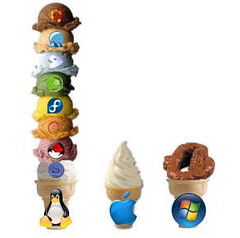You can never tell what happens with yourself next.
Did developers who started Mandrake project back in 1998 knew that their baby would become world famous operating system? But fate of this baby is not the easiest. It was renamed to Mandriva, remarketed, and finally split into at least two. I am talking about recent fork between Mandriva and Mageia. Of course, there were other forks before, but recent one was the most serious in the whole history.
But Mandriva as a project still exists. To prove this fact, new version of Mandriva Linux was released with codename Mandriva 2011 Hydrogen.
I have already written about Mandriva Linux several times. They were reviews of Mandriva 2010.1 and 2010.2, based on KDE. Up to that point Mandriva released different spins of their operating system: one CD iso image for GNOME and another for KDE version.
Latest Hydrogen release is different here. It only has KDE version. Other DEs were deprecated, although still available from community. And new ISO image weights more than 1.6 Gb. This is significantly more than previous versions which could fit standard CD. By the way, for limited time only you can still get CD with previous version of Mandriva from Buy Linux CDs web shop!
I was not much impressed with previous releases of Mandriva. But Mageia quickly became my distribution #1. That's why I was very curious how much Mageia 1 was different from Mandriva 2011.
It was time for me to create Live USB for Mandriva. Previous versions of this OS had special tool called "Mandriva Seed" to create Live USB. This time round I decided to use something more generic. And I was lucky! My Live USB was created from iso image with simple dd command. Same method is mentioned in release notes, if you bother to read them.
So, USB stick is in the port. Reboot. Choose to boot from USB. Let's go!






![An update / upgrade is available for your [linux / windows / mac] computer...via stickycomics.com](http://farm6.static.flickr.com/5176/5497202855_6e785e0c38.jpg)




